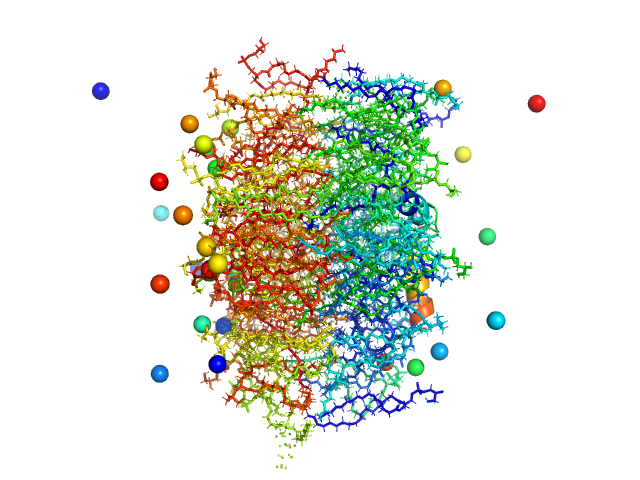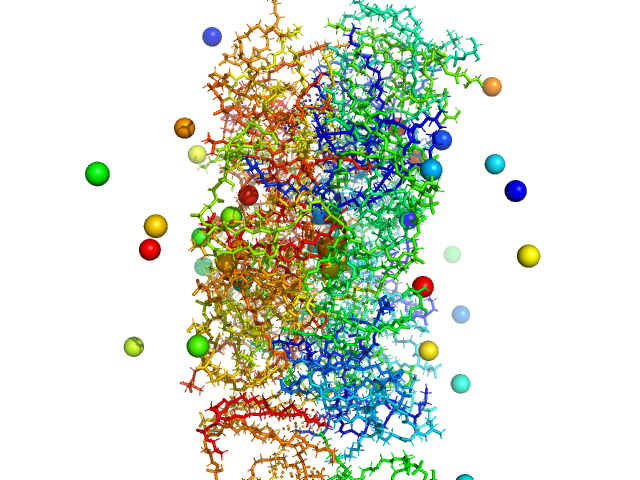|
Anisotropic synchrotron SAXS data from a Gram-positive bacteria lipid membrane mimic deposited onto silicon wafer in the presence of antimicrobial peptide WLBU2 fully hydrated with water, pH 7 were collected on the G1 beam line at the Cornell High Energy Synchrotron Source (CHESS) storage ring (Ithaca, NY, USA) using a Eiger X 1M detector at a sample-detector distance of 0.4 m and at a wavelength of λ = 0.084 nm (I(s) vs s, where s = 4πsinθ/λ, and 2θ is the scattering angle). The sample temperature was maintained at 37°C. Two successive 30 second frames were collected and the 2D data analysed along the principle s-z axis.
This is a mimic of a Gram-positive bacterial membrane with an antimicrobial peptide included at a 75:1 molar ratio. The sample is 4 mg of Gram-positive lipid model membrane oriented onto a silicon wafer, hydrated fully through the vapor. The area/lipid is 0.809 +/- 0.028 sq. nm. The lipid is deposited using the rock and roll procedure where the lipid (and peptide if present) is solubilized in two organic solvents - one to dissolve the lipid and the other to spread the lipid solution onto the silicon wafer. All of the organic solvent is removed under vacuum for at least two hours, after the lipid is initially dry. The sample is trimmed to a thin strip (5 mm wide) in the center of the silicon wafer. The width of the wafer is 1.5 cm and its length is 3 cm. It is 1 mm thick. The sample is fully hydrated in a thick-walled hydration chamber. The sample is rotated in the x-ray beam during the data acquisition. For more detail regarding this kind of sample please see: Kučerka, N., Liu, Y. F., Chu, N. J., Petrache, H. I., Tristram-Nagle, S. & Nagle, J. F. (2005). Structure of fully hydrated fluid phase DMPC and DLPC lipid bilayers using X-ray scattering from oriented multilamellar arrays and from unilamellar vesicles. Biophys J 88, 2626-2637. The data analysis uses liquid-crystal theory to obtain the bending modulus and the compressibility modulus. These are needed to obtain the structure factor. The form factor is then obtained as described in: Lyatskaya, Y., Liu, Y., Tristram-Nagle, S., Katsaras, J. & Nagle, J. F. (2001). Method for obtaining structure and interactions from oriented lipid bilayers. Phys Rev E Stat Nonlin Soft Matter Phys 63, 011907. The gram-positive mixture consists of a 6:1.5:1.5:1 molar ratio of: 1-palmitoyl-2-oleoyl-sn-glycero-3-phospho-(10-rac-glycerol) (POPG), 1,2-dioleoyl-3-trimethylammonium-propane (DOTAP), 1-palmitoyl-2-oleoyl-sn-glycero-3-phosphoethanolamine (POPE), 10,30-bis-[1,2-dioleoyl-sn-glycero-3-phospho]-sn-glycerol (Cardiolipin 18:1) with the RRWVRRVRRWVRRVVRVVRRWVRR peptide.
|
|
 s, nm-1
s, nm-1
![Static model image 1-palmitoyl-2-oleoyl-sn-glycero-3-phospho-(10-rac-glycerol), 1,2-dioleoyl-3-trimethylammonium-propane, 1-palmitoyl-2-oleoyl-sn-glycero-3-phosphoethanolamine, 10,30-bis-[1,2-dioleoyl-sn-glycero-3-phos OTHER [STATIC IMAGE] model](/media//pdb_file/SASDNZ4_fit1_model1.png)

